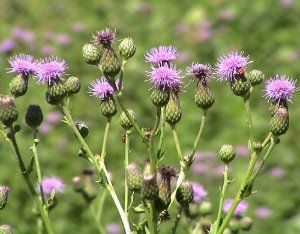Description: Field Thistle, scientifically known as Dipsacus fullonum, is a tall and robust herbaceous plant belonging to the teasel family (Dipsacaceae). It is characterized by its distinctive pink to purple flower heads, which appear atop tall, spiny stems. The plant is native to Europe and Asia but has become widespread in various parts of North America.
Habitat and Distribution:
Field Thistle is commonly found in open fields, meadows, and along roadsides. It thrives in areas with well-drained soil and full sunlight. While it prefers moderate to wet soil conditions, Field Thistle can adapt to a range of habitats.
Physical Features:
Height: Field Thistle can reach impressive heights, often exceeding six feet.
- Leaves: The plant features large, prickly leaves that form a rosette at the base of the stem.
- Flowers: The distinctive pink to purple flower heads, blooming in summer, attract pollinators such as bees and butterflies.
- Seeds: Field Thistle produces spiky seed heads, creating a visually striking appearance in late summer and fall.
Ecological Role:
Field Thistle plays a vital role in supporting pollinators and providing habitat for various insects. The nectar-rich flowers attract bees and butterflies, contributing to the overall biodiversity of the ecosystem. Additionally, the seeds of Field Thistle are a valuable food source for birds.
Cultural Significance:
While some may consider Field Thistle a weed due to its ability to colonize disturbed areas, others appreciate its ornamental qualities and ecological benefits. The spiky seed heads are often used in dried flower arrangements, adding a unique and textural element.
Control and Management:
For those wishing to control the spread of Field Thistle, it's essential to employ targeted strategies:
- Mechanical Control: Regular mowing can help manage Field Thistle populations by preventing the formation of seed heads. However, care should be taken to avoid disturbing beneficial pollinators.
- Hand Removal: Hand pulling or cutting of individual plants can be effective for small infestations. Be cautious of the spines on the leaves and stems.
- Herbicides: In cases where mechanical methods are impractical, selective herbicides can be used to control Field Thistle. Always follow guidelines and regulations regarding herbicide application.
Promoting Native Plants:
Encouraging the growth of native vegetation can help outcompete Field Thistle and maintain a balanced ecosystem. Select plants that thrive in your specific region and soil conditions.
In conclusion, while Field Thistle possesses ornamental qualities and ecological benefits, its invasive nature requires careful management. By employing targeted control methods and promoting a diverse plant community, it is possible to strike a balance that preserves both the beauty of Field Thistle and the health of the surrounding environment.



